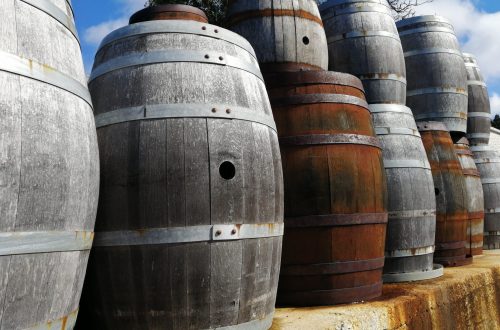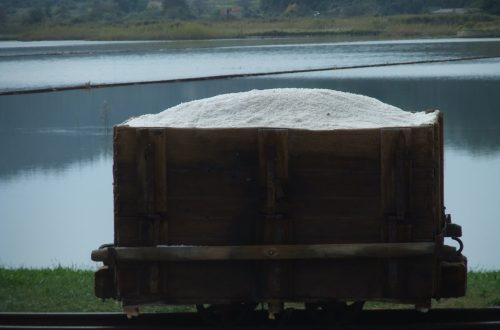Croatia is famous for its wine, and the Pelješac region is no exception. The peninsula comprises over 3,000 hectares of vineyards and olive groves and is a stronghold of Mali Plavac, the Little Blue. The grape is an old, red grape variety whose history of cultivation probably dates back to the Illyrians. It is not only used to make the famous Dingač, but also wines with the simple names Plavac, Plelješac or Postup. Not far from our guest house, in the Potomje area, Dingač – pronounced dingatj – is made from it. The autochthonous Mali Plavac grapes, which are harvested very late and in some cases have already been raisined, produce one of Croatia’s best-known and top-quality red wines. Another star wine of the peninsula is Postup.
Here we present a selection of the many wineries in our neighbourhood in 3 categories. They were all tasted for us by our lovely guests Mary and Rick. 🙂 Thank you!

CATEGORY 1 There are some newer, unusual top wineries in our neighbourhood. They produce quality wines that are relatively expensive. Visitors enjoy a beautiful view on site as well as a nice ambience with a slightly more formal service. They prefer that you call ahead, but will do their best to accommodate you if you just drop in. They may be closed for a while in the afternoon.
– Grgic Vina, Trstenik Founded by the famous Croatian winemaker Miljenko Grgic (now 100 years old), who has made a name for himself as a winemaker in California, where he runs the Grgich Hills Estate. His Chateau Montelena Chardonnay from 1973 prevailed against several white wines from Burgundy and won the prestigious “Judgement of Paris”.
The elegant Grgic Vina winery is located on a small peninsula directly above the sea and offers a dramatic view of the Dingač mountain and the steep vineyards. The courtyard is open and airy; a perfect place to enjoy Posip and Plavac Mali wines. These wines are quite good, but also quite expensive. However, the tasting is reasonably priced (and the cost can be waived if you buy a wine). A lovely experience.
– Saints Hills Winery, Zagrunda An impressive stone building on a hill overlooking the vineyards. It has a beautiful, airy courtyard for wine tasting. There may be a short (20 minute) guided tour of the winery and its history. It is a family business with three vineyards in different locations on Pelješac and in Istria.
The winery has a restaurant and accommodation. The tasting service is rather formal but respectful; it seems that the service in the restaurant is similar. A variety of different Croatian wines are offered. The wines are well made but not convincing in their somewhat expensive price range. The cost of just tasting them is also a bit high. Nevertheless, the scenery is very beautiful and wines are plentiful. A good experience.
– Korta Katarina Winery, Orebic This winery is prominently located at the entrance to Orebić and is part of a large hotel. This is the closest winery to Viganj.

CATEGORY 2 There are also smaller, family-run wineries. They appear pragmatic, dramatic views and ambience are not important here. Sometimes they are run by family members. Here are a few examples:
– Boris Violic Winery, Potomje The small tasting room is located in the family’s main house and is run by the winemaker’s wife, Marina. She is friendly, talkative and very helpful. The wines come from good vineyards around the peninsula and are well made. They are also quite reasonably priced. A fun way to experience the family wine culture of the peninsula.
– Vinarija Matusko, Potomje A medium-sized, family-owned winery. The large tasting room can accommodate larger groups of visitors. The staff are knowledgeable and friendly. They offer a whole range of different Croatian wines in different price categories. There is also a large wine cellar under the tasting room that you may be able to visit. The wines are well made and most are reasonably priced. Cash only.
– Vinarija Madirazza, Potomje A medium-sized, family-owned winery. A very large and well equipped tasting room with very helpful and knowledgeable staff. They produce a large number of different Croatian wines; if you show interest, the staff will quickly draw your attention to the small production offerings that are only available at the winery. Many of the red wines are older vintages – 5 to even 10 years old. Well-made wines at reasonable prices.

CATEGORY 3 There are many small, family-run wine shops along the main roads on the Pelješac peninsula. They usually sell their own homemade products. It’s fun to strike up a conversation with the local winemakers.
Regardless of the size and style of the winery, the most important grape variety on the peninsula is the red grape variety Plavac Mali. It is used to make an intense, tannic wine, the flavours of which can range from Syrah to Petite Verdot to Granache.
The best Plavac Mali comes from the Dingač appellation on the south-west side of the peninsula on the Adriatic. The grapes are exposed to intense sunlight and sea breezes and grow on very steep limestone cliffs, which means that they are subjected to a corresponding amount of stress. Dingač was the first region in Croatia to receive an application-based designation (and protection from others using the name) in the 1960s.
The Postup region, a little further south-west of Dingač, was the second designated wine-growing area in Croatia. It also consists of steep slopes facing the sea. The Plavac Mali grown there is only slightly less intense.
On the other side of the hill (a few hundred metres north of Dingač) is a valley with somewhat more fertile soil that retains a little more moisture. Plavac mali is also mainly grown there. It is also very good, but somewhat less intense (and cheaper) than the wines from Dingač or Postup.
OTHER WINE CELLARS on Korčula:
There are several wine shops in the town of Korčula (approx. 100 metres south of the Great Land Gate). However, the wineries are located in other partly famous wine-growing areas of the island. The town



